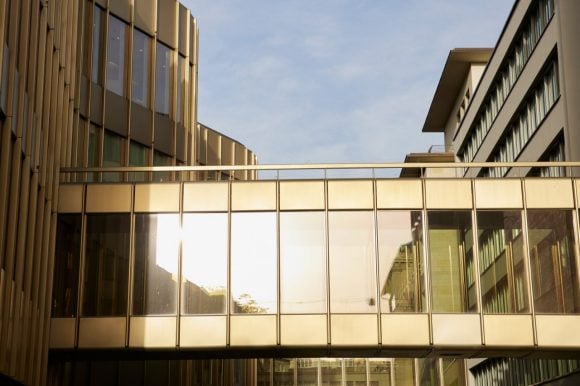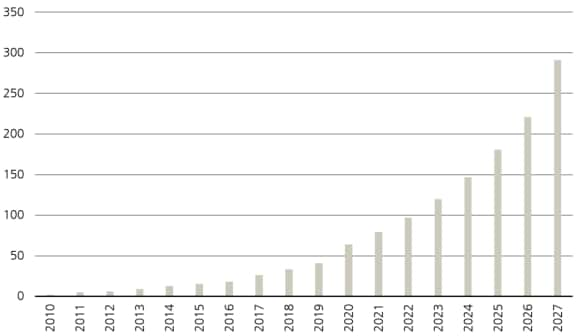
Although we think the bulk of the correction had occurred by the end of 2023, we expect capital values to bottom out in 2024. Of course, not all markets, geographies or sectors in real estate are equal. Assessing the dominant themes is key to finding specialist investments in niche subsectors of real estate.
Fergus Hicks ‒ Real Estate Strategist, Real Estate & Private Markets
From niche to norm: the substance in real estate subsectors
From niche to norm: the substance in real estate subsectors
2023 was a year of prolonged high inflation, sharp interest rate hikes and a weak economy, with looming fears of recession. However, most countries proved resilient and avoided recession. Now, as markets can see disinflation and signs of interest rates at their peak, there may be light at the end of the tunnel and a path to improved market conditions in 2024. Although we think the bulk of the correction had occurred by the end of 2023, we expect capital values to bottom out in 2024. Of course, not all markets, geographies or sectors in real estate are equal. In addition to the continued challenges from geopolitical tensions, the world is changing, shaped by megatrends such as the post pandemic ‘future of work’ impact on office space, aging population, focus on sustainability and digitalization. Assessing these dominant themes is key to finding specialist investments in niche subsectors of real estate that will drive returns and have the potential to become established in the long term.
The impact of government sustainability incentives on office space
The impact of government sustainability incentives on office space
Offices which lack sustainable features and suffer from weak demand can avoid obsolescence by being refurbished into modern offices or repurposed to other uses, such as residential. In the US, the Biden-Harris administration is supporting conversion of high vacancy commercial buildings to residential with the aim of creating affordable, energy-efficient housing near transit and good jobs. In 2023, the White House released the “Commercial to Residential Conversions” guidebook on the federal resources available, covering 20 federal programs to support conversions, including low interest loans and tax incentives.
However, retrofitting can be seen as the preferred, less carbon intensive solution.
In 2023, the Singapore government launched the SGD 63 million Green Mark Incentive Scheme to fund retrofitting projects based on their expected emissions reduction. In the UK, the Minimum Energy Efficiency Standards regulation requires landlords of commercial properties to have a minimum Energy Performance Certificate rating of E (B in 2030), to avoid a penalty of up to GBP 150,000. And in the US, the Inflation Reduction Act 2022 provides tax incentives such as the commercial buildings energy efficiency tax deduction which enables building owners to claim a tax deduction for installing qualifying systems.
Overall, we expect more schemes to be launched across countries and niche opportunities to emerge in this area. Affordable housing, particularly in cities in most advanced economies, is in short supply. Combined with sustainability incentives, this presents an investment opportunity as governments look to partner with institutional investors to help deliver affordable housing at scale for their populations to improve living conditions and social welfare. Affordable housing also gives investors an opportunity to take part in socially beneficial investments.
Green real estate assets have moved from a sub sector of real estate investing to become more established as data and demand grows.
Our recent research finds clear evidence of a green premium in the two largest office building markets, New York and London. We examined 1,453 office building transactions in New York and London between 2010 and 2022, running a regression to analyze the economic implications of environmentally certified commercial real estate while controlling for a wide range of factors. On a price per square foot basis, New York and London see material green premiums of 28% and 19% respectively (all else being equal; i.e. location, age, renovation, occupancy, and lease length). Green assets, not specifically office space, generally exhibit higher value because of factors such as shorter vacancy periods, lower obsolescence, decreased depreciation, reduced operating costs, shorter tenant agreements and improved tenant retention.
The life sciences real estate sector: high demand and demographics
The life sciences real estate sector: high demand and demographics
With an aging population and the post pandemic need for further medical research, the demand for properties specifically designed and built for companies within the life sciences industry is increasing in Europe, which is behind the US. Life sciences companies need high-specification facilities that meet their unique needs. Some of those requirements relate to aspects such as the number of air changes per hour within a laboratory, the mechanical engineering that goes in to support these types of features, the vibration criteria of the floors – considerations not typical for an office building. They can vary by different user types, whether the tenant is focused on biology, chemistry or technology and require significant investment.
The role of the real estate sector to provide these more specialized facilities is becoming ever more important. With life sciences, particularly in the UK and Europe, many of the facilities don’t yet exist today, and so there is a very strong level of demand but very little supply. That supply/demand imbalance is supportive of rental growth in the sector, while the prospect of rental growth is not as strong in the traditional sectors. Particularly when cap rates and exit yields are more challenging, gaining return through income growth is attractive for real estate investors. Equally, sustainability themes are important for investors, and the life sciences sector can meet many of those expectations, both on the social and environmental sides.
In the UK, there is the Golden Triangle of Cambridge, Oxford and London, which is internationally recognized because of the strength of the universities, the R&D work and the hospitals. This area has taken the lion’s share of life sciences investment that comes into the UK. A theme we’ll likely see during the next few years is that other UK areas will continue to develop into areas of excellence. We see it is already happening in many areas in the north of England and Scotland. While that trend will continue to play out, the Golden Triangle will likely retain its majority share due to the depth of the market and its connectivity into Europe and the US.
In the EU, because of the number of countries and competing clusters, it is harder to pick a cluster because the market is in an earlier stage. We see a huge amount of potential across the Netherlands, Germany, France, Switzerland and Belgium. The three key elements that make up a successful cluster are the academic environment, hospitals and pharmaceutical companies. Those have traditionally been spoken about as the key drivers of a successful cluster. But people recognize skilled workforce availability as another key driver. That has traditionally overlapped with where large pharmaceutical firms have had a presence. On the manufacturing side, space, infrastructure, logistics, and servicing needs to be accounted for.
Digitalization – the promise of artificial intelligence
Digitalization – the promise of artificial intelligence
Artificial intelligence (AI) has many applications in real estate investing because a single investment can generate almost limitless amounts of data. Programs can ‘read’ existing documents – like leases – store key variables and flag important terms. AI can help tie disparate data sources together such as underwriting metrics, people flow, amenity usage, revenue, utilities, sustainability, mechanicals health and repair work orders. Firms with large datasets could use AI to create customized benchmarks.
Many national asset management teams use AI in analyzing rental rate data to predict optimal unit pricing using real-time data and inputs. Future possible applications include real-time tenant credit analysis, market data trends, adaptation of floorplates and amenity spaces to tenant demand, prediction of environmental transition risk, adding alternative data to traditional underwriting (examples: mobile data, package flows, market-based amenity demand) and automated valuation models.
Better data analysis will likely emerge from the current hype around AI and drive growth in a sub-sector of real estate investing. The demand for digital connectivity throughout the world is well established but not yet met as a digital divide still exists in most countries as well as a demand for more sector specific real estate, such as data centers to accommodate innovation. For example, the annual datasphere, which measures the amount of new data created globally, is expected to double as soon as 2027 and indicates strong growth in demand for data centers ahead.
Annual size of global datasphere (zettabytes)

Historically, niche sectors have played a key role in the development of real estate markets and look set to do so again. For example, at the turn of the millennium industrial property was relatively niche and, according to MSCI data, accounted for just 11% of the global market by value. By contrast in 2022 its share had risen to 25% and the property type had become mainstream. We think property types such as lab space, data centers and some specialist types of residential and living real estate, as addressed in this article, all have the potential to follow in industrial’s footsteps and become important and significant parts of the global real estate market.
Want more insights?
Want more insights?
Subscribe to receive the latest private markets perspectives and insights across all sectors directly to your inbox.
Make an inquiry
Fill in an inquiry form and leave your details – we’ll be back in touch.
Introducing our leadership team
Meet the members of the team responsible for UBS Asset Management’s strategic direction.

